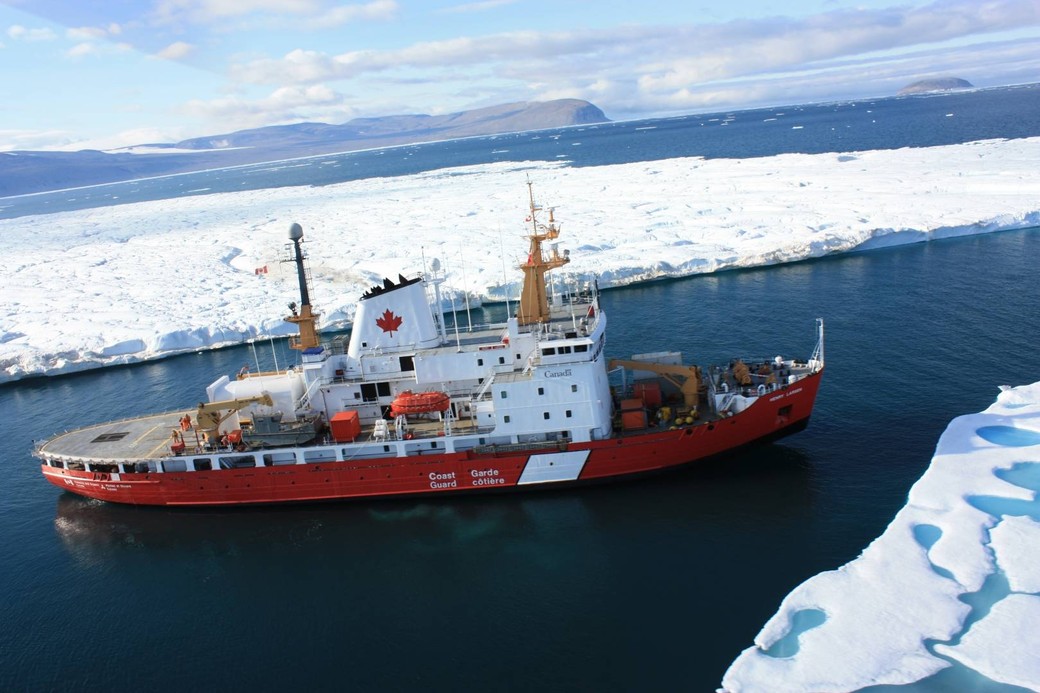
Why You Should Never Turn Your Back on the Sea
In our continuing series on the Canadian Coast Guard we look at some rescues and learn some valuable lessons about the power of the sea.
“Never turn your back on the ocean” is an old Hawaiian saying. It is sage advice for any mariner. Most sailors are aware that the ocean is a dangerous and unforgiving place. Yet, as Thomas E. Appleton writes in Usque Ad Mare: A History of the Canadian Coast Guard and Marine Services: “Seamen (of the past) were cynical about safety procedures which are nowadays considered appropriate. In fact, very few of them could swim.” It seems unthinkable today but that was the case.
There are countless stories of survival and battles with that mysterious and unpredictable force known as the sea. There is no other Canadian organization that knows this more than the Canadian Coast Guard (CCG).
On the morning of February 22, 2009, some 400 kilometres due east of St. John’s, the Spanish fishing trawler Monte Galineiro caught fire and began listing violently to her port side. It soon became clear that the trawler could no longer stay afloat, leading the crew to send out a distress message and abandon ship. Most crew members left without the protection of an immersion suit, a lifejacket or, in one case, anything other than underwear — proof positive that the sea can catch you off guard.
Within 20 minutes of the first sign of trouble, the Monte Galineiro was swallowed by the North Atlantic. Yet luck would have it that the Canadian Coast Guard’s CCGS Leonard J. Cowley was only about two miles away. Its captain, Derek LeRiche, had been observing the Monte Galineiro, intending to board and inspect the fishing trawler when he heard its Mayday message. Ten minutes later, the Leonard J. Cowley was on the scene.
The CCG has provided search-and-rescue services since its inception in January 1962. Sometimes, luck combines with skill for optimal performance — as was the case with the Monte Galineiro — but at other times the sea has different plans.
Early on January 30, 1993, the Cape Aspy, a scallop trawler, sailed out of Lunenburg on a calm sea headed for the fertile fishing grounds of Georges Bank. The Cape Aspy would never reach its destination. According to the Transportation Safety Board of Canada report, the Cape Aspy sailed “in a southwesterly direction at a speed of 10 knots, a course which gradually diverged from the protection of the coast, giving an increase in the roughness of the seas.” To allow easy movement by her crew, the Cape Aspy sailed into these rougher seas with “many weathertight/watertight openings to the hull in the open or in the closed but unsecured position.” As the trawler sailed on, its increased speed, coupled with stronger wind and spray and temperatures of minus 20º, contributed to create a build-up of ice on its superstructure. The rough sea was positioning the increasingly top-heavy Cape Aspy for trouble.
Around 11 p.m., the Cape Aspy began to list to starboard as ferocious waves washed over its deck. Fifteen minutes later, “the vessel rolled heavily to starboard, partially returned to the upright and then rolled further to starboard; the list suddenly increased to about 45 degrees and the vessel appeared to be ‘settled by the head.’” Cape Aspy was dying.
As she filled with frigid water, all but two of her 16 crew members managed to climb into thermal immersion suits. When the order to abandon the listing ship was given, these crew members, minus the ship’s master, inched their way toward an inflatable life raft on the port side of Cape Aspy’s stern by slipping and sliding along the ice-covered wall of the wheelhouse.
As the life raft was inflating — a process taking only a few seconds — a powerful wave swept it and 15 crew members into the sea. “Two of the crew members managed to enter the life raft and they assisted others to board from the sea. The mate and three crew members could not reach the life raft, and the strong winds caused it to drift away. Reportedly, the master did not manage to leave the wheelhouse,” the inquiry found.
Although the Cape Aspy sent out distress messages, “they were not received by any shipboard or shore-based radio station, probably due to ice accretion on the Cape Aspy antenna.” In fact, as the inquiry report put it, “the only indication of distress was provided by the vessel’s Class I Emergency Position Indicating Radio Beacon (EPIRB) which floated free and activated automatically after the vessel sank.” Once the EPIRB was activated, CCG and commercial vessels together with search-and-rescue aircraft began the search. At 1:45 a.m., an aircraft homed into the EPIRB, sighting a life raft in the rough water 40 minutes later. At 3:42 a.m., surface vessels directed to the scene by aircraft plucked 10 of the Cape Aspy’s crew members out of the life raft. An hour or so later, another ship nearby scooped up an immersion-suit-clad survivor floating in the water. The bodies of three crew members were later recovered, but two men were never found.
Tragedy struck again five years later when, on January 16, 1998, a bulk carrier named the Flare encountered a violent winter storm 45 miles to the southwest of Saint Pierre and Miquelon. Facing gale-force winds, the Flare was being pounded by waves in excess of 16 metres. Carrying less than the required minimum ballast for an Atlantic crossing, the Flare was riding dangerously high on the water. Had the Flare been more heavily ballasted, she would have ridden lower and better absorbed the sea’s pounding.
Around midnight, the ocean began to get the better of the Flare. A deafening bang drowned out the howling wind and roaring waves as the hull began to flex more markedly. Yet, after investigation, the Flare did not appear to be in immediate danger. That appraisal of the situation changed four hours later.
At 4:30 a.m., a second bang echoed through the ship, followed by violent hull vibrations. This time, the Flare had broken in two. The entire crew was standing on the stern section as it suddenly listed to starboard. The men watched helplessly as the bow section floated away in the rough sea. They slid along the snow-and-ice-covered decks, making their way in total darkness to the Flare’s lifeboats. Unfortunately, the ship’s increasing starboard list prevented the starboard lifeboat from being launched. Repeated attempts to launch the port lifeboat were also fruitless. The crew’s last resort was to launch a life raft over the ship’s stern, but before the crew could climb in, the life raft was washed away.
Within 30 minutes of the Flare breaking in two, the stern section had disappeared beneath the surface along with all but six members of the crew. These six men clung to the capsized port lifeboat, which had broken free of its moorings as the Flare sank. Two of the initial survivors succumbed to exhaustion and the sea. When a search-and-rescue helicopter located the remaining four survivors six hours after they had plunged into the frigid water, the magnitude of the destruction was fully visible. Additional helicopters, fixed-wing aircraft and CCG surface vessels surveyed the Flare’s grave, a scene that included a lingering oil slick extending some 10 miles to the west and about three miles in a north-south direction, an empty lifeboat, two vacant life rafts and 15 oil-soaked bodies, as well as the bow section of the Flare which remained afloat for four days after its sundering.
Before the crew abandoned ship, a “hurried, indistinct and incomplete Mayday” was sent out on a very high frequency (VHF) radiotelephone. Yet, that distress message appeared to be from an unidentified vessel. It would take some time before the vessel in trouble would be identified as the Flare and the incomplete information could be analyzed.
CCG’s director-general of operations, Wade Spurrell, says that when it comes to search and rescue, many variables are involved, especially when ships don’t follow regulations or respect the force and power of the sea. Normally, when a ship issues a distress call by radio, “that signal would be picked up by the CCG radio traffic stations and the information would be relayed to one of our rescue coordination centres. Once the call goes in and the information is interpreted, the coordinator determines what assets are available and then tasks a primary resource –usually a Coast Guard surface vessel or a search-and-rescue aircraft functioning in coordination with the Department of National Defence.
“The search-and-rescue system is built on partnerships,” Spurrell noted. “In an operational context, DND is the lead department. The Royal Canadian Air Force has the knowledge and experience with their air assets, while the Canadian Coast Guard brings our knowledge of the marine environment and expertise. The typical response time for a primary asset is no more than thirty minutes. If it’s more, we would have to investigate why it took longer than thirty minutes. Where it gets more complicated is when we have only a snippet of information [as was the situation with the Flare]. In those cases, the controller might decide to task aircraft and ships to determine the nature of the incident. Most of the advancements in reducing the gap between the time when a distress signal comes in and the time when search-and-rescue technicians arrive on the scene of a vessel in distress are technological.”
Some of these time-reducing, life-saving technological advancements include satellite positioning and more accurate satellite-based emergency-locating beacons; improvements in radar; infrared cameras which are used to search for heat signals to help locate missing sailors; night vision gear; advancements in computer-based programs to run search modeling; sophisticated drift buoys that can be dropped from a ship or aircraft to simulate the drifting pattern of a lifeboat or a raft; and great advances in rescue boats, personal floatation devices and immersion (survival) suits. Nevertheless, as the Hawaiians know, you should never underestimate the power of the ocean. n
Top Photo: icyseas.org









